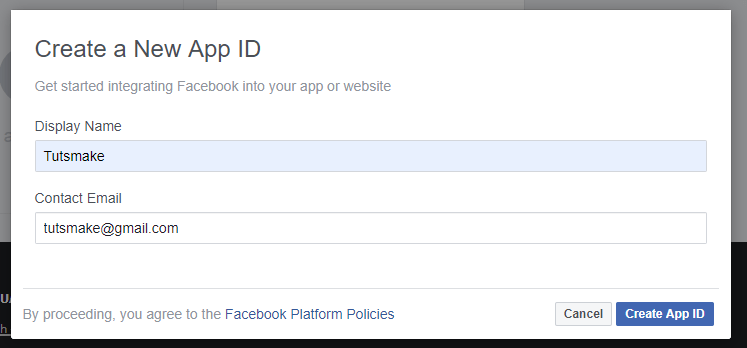PHP provides SDK for developers to add Facebook login to it. In this tutorial, you will learn how to create a login with Facebook login in PHP using SDK.
How to Login with Facebook in PHP?
Use follow the following easy steps to login with Facebook using PHP:
- Step 1 – Create a Facebook App
- Step 2 – Install Facebook PHP SDK v5
- Step 3 – Create index.php
- Step 4 – Create profile.php
Step 1 – Create a Facebook App
First of all, you have to make an app in the Facebook Developer Console.
Because when you create an app in the Facebook Developer Console. Then Facebook provides some secret details. With the help of which you can integrate and implement Facebook login in node js app.
If you do not know how to make apps on Facebook Developer Console. So you can make an app in the Facebook Developer Console by following the steps given below:
Step 1 – Visit the following url https://developers.facebook.com/apps/ and create a new facebook app.
Step 2 – Create facebook app with email and app name look like below picture:

Step 3 – Then, Navigate to setting->advanced and add redirect URL, looks like below picture:

Step 4 – Now, add valid auth redirect url. So, click facebook login->setting and add valid auth redirect URL, looks like below picture:

Step 5 – Finally, Navigate to facebook developers dashboard and copy the following App ID and App SECRET, looks like below picture:

Now, save facebook secret id and secret key,Which is found from the Facebook Developer Console App.
Step 2 – Install Facebook PHP SDK v5
Install facebook PHP SDK v5. So, Open the command prompt and then go to project root directory and execute the below-given command to install facebook PHP sdk v5:
// project root directory cd/project_root_directory composer require facebook/graph-sdk
Step 3 – Create index.php
Create an index.php file, so visit app root directory and create it. This file code will show the facebook login.
So update the below code into index.php file
<?php
//initialize facebook sdk
require 'vendor/autoload.php';
session_start();
$fb = new Facebook\Facebook([
'app_id' => 'fb_key_id',
'app_secret' => 'fb_secret_id',
'default_graph_version' => 'v2.5',
]);
$helper = $fb->getRedirectLoginHelper();
$permissions = ['email']; // optional
try {
if (isset($_SESSION['facebook_access_token'])) {
$accessToken = $_SESSION['facebook_access_token'];
} else {
$accessToken = $helper->getAccessToken();
}
} catch(Facebook\Exceptions\facebookResponseException $e) {
// When Graph returns an error
echo 'Graph returned an error: ' . $e->getMessage();
exit;
} catch(Facebook\Exceptions\FacebookSDKException $e) {
// When validation fails or other local issues
echo 'Facebook SDK returned an error: ' . $e->getMessage();
exit;
}
if (isset($accessToken)) {
if (isset($_SESSION['facebook_access_token'])) {
$fb->setDefaultAccessToken($_SESSION['facebook_access_token']);
} else {
// getting short-lived access token
$_SESSION['facebook_access_token'] = (string) $accessToken;
// OAuth 2.0 client handler
$oAuth2Client = $fb->getOAuth2Client();
// Exchanges a short-lived access token for a long-lived one
$longLivedAccessToken = $oAuth2Client->getLongLivedAccessToken($_SESSION['facebook_access_token']);
$_SESSION['facebook_access_token'] = (string) $longLivedAccessToken;
// setting default access token to be used in script
$fb->setDefaultAccessToken($_SESSION['facebook_access_token']);
}
// redirect the user to the profile page if it has "code" GET variable
if (isset($_GET['code'])) {
header('Location: profile.php');
}
// getting basic info about user
try {
$profile_request = $fb->get('/me?fields=name,first_name,last_name,email');
$requestPicture = $fb->get('/me/picture?redirect=false&height=200'); //getting user picture
$picture = $requestPicture->getGraphUser();
$profile = $profile_request->getGraphUser();
$fbid = $profile->getProperty('id'); // To Get Facebook ID
$fbfullname = $profile->getProperty('name'); // To Get Facebook full name
$fbemail = $profile->getProperty('email'); // To Get Facebook email
$fbpic = "<img src='".$picture['url']."' class='img-rounded'/>";
# save the user nformation in session variable
$_SESSION['fb_id'] = $fbid.'</br>';
$_SESSION['fb_name'] = $fbfullname.'</br>';
$_SESSION['fb_email'] = $fbemail.'</br>';
$_SESSION['fb_pic'] = $fbpic.'</br>';
} catch(Facebook\Exceptions\FacebookResponseException $e) {
// When Graph returns an error
echo 'Graph returned an error: ' . $e->getMessage();
session_destroy();
// redirecting user back to app login page
header("Location: ./");
exit;
} catch(Facebook\Exceptions\FacebookSDKException $e) {
// When validation fails or other local issues
echo 'Facebook SDK returned an error: ' . $e->getMessage();
exit;
}
} else {
// replace website URL same as added in the developers.Facebook.com/apps e.g. if you used http instead of https and used
$loginUrl = $helper->getLoginUrl('https://tutsmake.com/Demos/php-facebook', $permissions);
echo '<a href="' . $loginUrl . '">Log in with Facebook!</a>';
}
?>
Step 4 – Create profile.php
Create a profile.php file, so visit app root directory and create it. This file code will show logged-in user information like name, email, avatar, etc.
So update the below code into profile.php file:
<?php
session_start();
?>
<head>
<title>Login with Facebook in PHP</title>
<link rel="stylesheet" href="https://stackpath.bootstrapcdn.com/bootstrap/4.1.3/css/bootstrap.min.css">
</head>
<body>
<?php if($_SESSION['fb_id']) {?>
<div class = "container">
<div class = "jumbotron">
<h1>Hello <?php echo $_SESSION['fb_name']; ?></h1>
<p>Welcome to Tutsmake.com</p>
</div>
<ul class = "nav nav-list">
<h4>Image</h4>
<li><?php echo $_SESSION['fb_pic']?></li>
<h4>Facebook ID</h4>
<li><?php echo $_SESSION['fb_id']; ?></li>
<h4>Facebook fullname</h4>
<li><?php echo $_SESSION['fb_name']; ?></li>
<h4>Facebook Email</h4>
<li><?php echo $_SESSION['fb_email']; ?></li>
</ul>
</div>
<?php } ?>
</body>
</html>
thanks for this post it’s vary helpfull for me..
there have no code for logout page